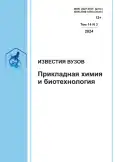Synthesis of sodium 1,3-propanebis(dithiocarbamate) and study of its flotation properties
- Authors: Sakhabutdinova T.K.1, Vchislo N.V.2, Verochkina E.A.2, Fedoseeva V.G.2, Burdonov A.E.1, Rozentsveig I.B.2,3
-
Affiliations:
- Irkutsk National Research Technical University
- A.E. Favorsky Irkutsk Institute of Chemistry SB RAS
- Irkutsk State University
- Issue: Vol 14, No 3 (2024)
- Pages: 428-435
- Section: Brief communication
- URL: https://ogarev-online.ru/2227-2925/article/view/302268
- DOI: https://doi.org/10.21285/achb.934
- EDN: https://elibrary.ru/RIHDQY
- ID: 302268
Cite item
Full Text
Abstract
Keywords
About the authors
T. Kh. Sakhabutdinova
Irkutsk National Research Technical University
Email: statyana411@gmail.com
N. V. Vchislo
A.E. Favorsky Irkutsk Institute of Chemistry SB RAS
Email: vchislo@irioch.irk.ru
E. A. Verochkina
A.E. Favorsky Irkutsk Institute of Chemistry SB RAS
Email: kleptsova84@mail.ru
V. G. Fedoseeva
A.E. Favorsky Irkutsk Institute of Chemistry SB RAS
Email: vic_yol@mail.ru
A. E. Burdonov
Irkutsk National Research Technical University
Email: burdonovae@ex.istu.edu
I. B. Rozentsveig
A.E. Favorsky Irkutsk Institute of Chemistry SB RAS; Irkutsk State University
Email: i_roz@irioch.irk.ru
References
- Ajiboye T.O., Ajiboye T.T., Marzouki R., Onwudiwe D.C. The versatility in the applications of dithiocarbamates // International Journal of Molecular Sciences. 2022. Vol. 23, no. 3. P. 1317. doi: 10.3390/ijms23031317.
- Kaul L., Süss R., Zannettino A., Richter K. The revival of dithiocarbamates: from pesticides to innovative medical treatments // iScience. 2021. Vol. 24, no. 2. P. 102092. doi: 10.1016/j.isci.2021.102092.
- Viola-Rhenals M., Patel K.R., Jaimes-Santamaria L., Wu G., Liu J., Dou Q.P. Recent advances in Antabuse (Disulfiram): the importance of its metal-binding ability to its anticancer activity // Current Medicinal Chemistry. 2018. Vol. 25, no. 5. P. 506–524. doi: 10.2174/0929867324666171023161121.
- Kurian J.K., Peethambaran N.R., Mary K.C., Kuriakose B. Effect of vulcanization systems and antioxidants on discoloration and degradation of natural rubber latex thread under UV radiation // Journal of Applied Polymer Science. 2000. Vol. 78, no. 2. P. 304–310. doi: 10.1002/1097-4628(20001010)78:23.0.CO;2-G.
- Cvek B., Dvorak Z. Targeting of nuclear factor-κB and proteasome by dithiocarbamate complexes with metals // Current Pharmaceutical Design. 2007. Vol. 13, no. 30. P. 3155–3167. doi: 10.2174/138161207782110390.
- Бурдонов А.Е., Вчисло Н.В., Верочкина Е.А., Розенцвейг И.Б. Синтез новых производных ксантогенатов и дитиокарбаматов и их применение в процессах обогащения // Известия вузов. Прикладная химия и биотехнология. 2023. Т. 13. N 2. С. 160–171. doi: 10.21285/2227-2925-2023-13-2-160-171. EDN: PNMZLC.
- Campanale C., Triozzi M., Ragonese A., Losacco D., Massarelli C. Dithiocarbamates: properties, methodological approaches and challenges to their control // Toxics. 2023. Vol. 11, no. 10. P. 851. doi: 10.3390/toxics11100851.
- Bala V., Gupta G., Sharma V.L. Chemical and medicinal versatility of dithiocarbamates: an overview // Mini-Reviews in Medicinal Chemistry. 2014. Vol. 14, no. 14. P. 1021–1032. doi: 10.2174/1389557514666141106130146.
- Duan Y.-C., Zheng Y.-C., Li X.-C., Wang M.-M., Ye X.-W., Guan Y.-Y., et al. Design, synthesis and antiproliferative activity studies of novel 1,2,3-triazole–dithiocarbamate–urea hybrids // European Journal of Medicinal Chemistry. 2013. Vol. 64. P. 99–110. doi: 10.1016/j.ejmech.2013.03.058.
- Sheef A.F. A method for maintaining Phytomonas sepedonica in culture to long periods without transfer // Phytopathology. 1943. Vol. 33, no. 4. P. 300–332.
- He X.-Y., Lu L., Qiu J., Zou P., Yu F., Jiang X.-K., et al. Small molecule fusion inhibitors: Design, synthesis and biological evaluation of (Z)-3-(5-(3-benzyl-4-oxo-2thioxothiazolidinylidene)methyl)-N-(3-carboxy-4-hydroxy) phenyl-2,5-dimethylpyrroles and related derivatives targeting HIV-1 gp41 // Bioorganic & Medicinal Chemistry. 2013. Vol. 21, no. 23. P. 7539–7548. doi: 10.1016/j.bmc.2013.04.046.
- Harrison J.J., Turner R.J., Ceri H. A subpopulation of Candida albicans and Candida tropicalis biofilm cells are highly tolerant to chelating agents // FEMS Microbiology Letters. 2007. Vol. 272, no. 2. P. 172–181. doi: 10.1111/j.1574-6968.2007.00745.x.
- Xu L., Tong J., Wu Y., Zhao S., Lin B.-L. A computational evaluation of targeted oxidation strategy (TOS) for potential inhibition of SARS-CoV-2 by disulfiram and analogues // Biophysical Chemistry. 2021. Vol. 276. P. 106610. doi: 10.1016/j.bpc.2021.106610.
- Karimov A., Taslimi P., Orujova A., Mammadova K., Kısa D., Farzaliyev V., et al. Design, synthesis, characterization and biological activities of novel S-(acyloxy) butyl-N,N-diethyldithiocarbamate compounds // ChemistrySelect. 2023. Vol. 8, no. 18. P. e202300286. doi: 10.1002/Slct.202300286.
- Trawally M., Demir-Yazıcı K., Dingiş-Birgül S.İ., Kaya K., Akdemir A., Güzel-Akdemir Ö. Dithiocarbamates and dithiocarbonates containing 6-nitrosaccharin scaffold: Synthesis, antimycobacterial activity and in silico target prediction using ensemble docking-based reverse virtual screening // Journal of Molecular Structure. 2023. Vol. 1277. P. 134818. doi: 10.1016/j.molstruc.2022.134818.
- Soyka M., Roesner S. New pharmacological approaches for the treatment of alcoholism // Expert Opinion on Pharmacotherapy. 2006. Vol. 7, no. 17. P. 2341–2353. doi: 10.1517/14656566.7.17.2341.
- Singh A.N., Srivastava S., Jainar A.K. Pharmacotherapy of chronic alcoholism: a review // Drugs of Today. 1999. Vol. 35, no. 1. P. 27–33. doi: 10.1358/dot.1999.35.1.522944.
- Ma X., Hu Y., Zhong H., Wang S., Liu G., Zhao G. A novel surfactant S-benzoyl-N,N-diethyldithiocarbamate synthesis and its flotation performance to galena // Applied Surface Science. 2016. Vol. 365. P. 342–351. doi: 10.1016/j.apsusc.2016.01.048.
- Liu S., Liu G., Zhong H., Yang X. The role of HABTC’s hydroxamate and dithiocarbamate groups in chalcopyrite flotation // Journal of Industrial and Engineering Chemistry. 2017. Vol. 52. P. 359–368. doi: 10.1016/j.jiec.2017.04.015.
- Liu S., Dong Y., Xie L., Liu G., Zhong H., Zeng H. Uncovering the hydrophobic mechanism of a novel dithiocarbamate-hydroxamate surfactant towards galena // Chemical Engineering Science. 2021. Vol. 245. P. 116765. doi: 10.1016/j.ces.2021.116765.
- Katritzky A.R., Tarr R.D., Heilmann S.M., Rasmussen J.K., Krepski L.R. Synthesis and characterization of poly(-thiazole-2-thione)s // Journal of Polymer Science, Part A: Polymer Chemistry. 1987. Vol. 25, no. 12. P. 3205–3214. doi: 10.1002/pola.1987.080251203.
Supplementary files










